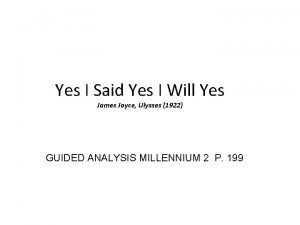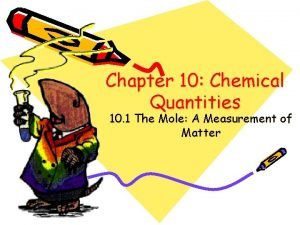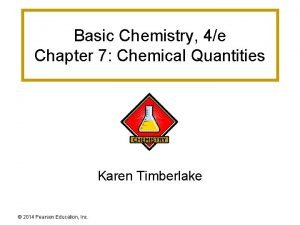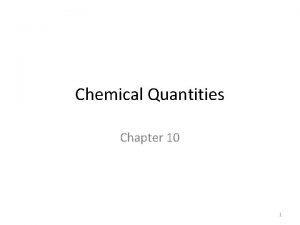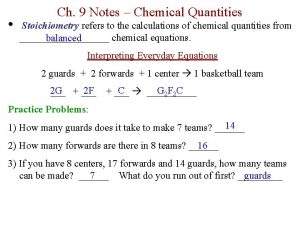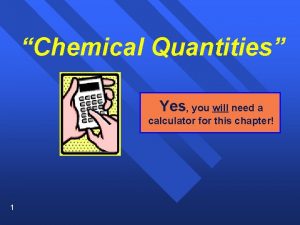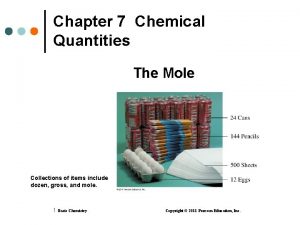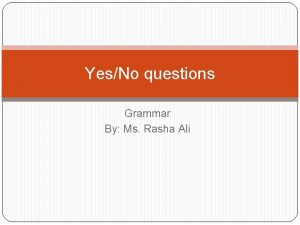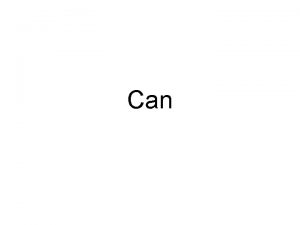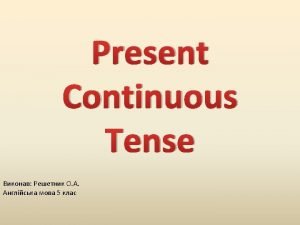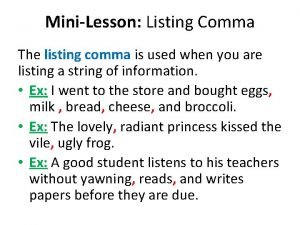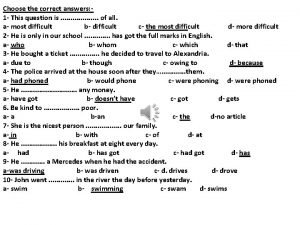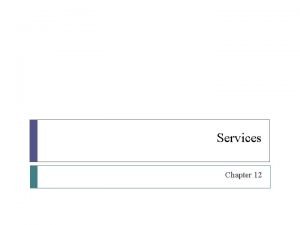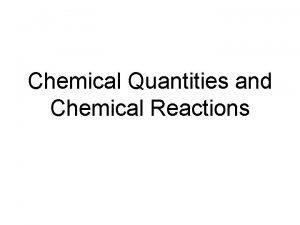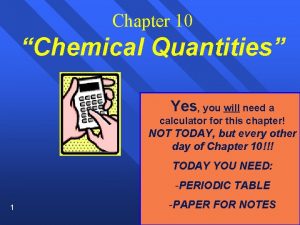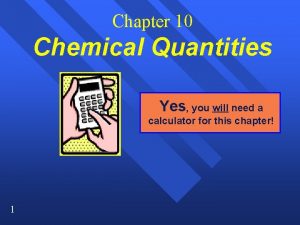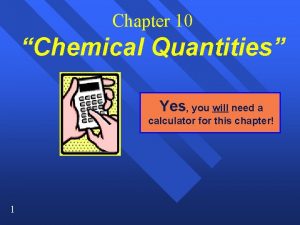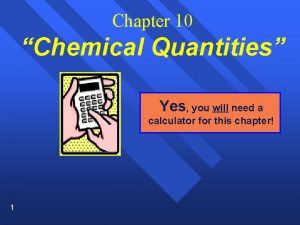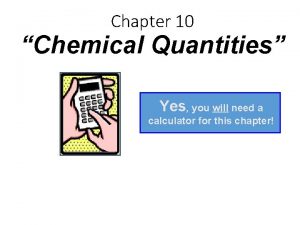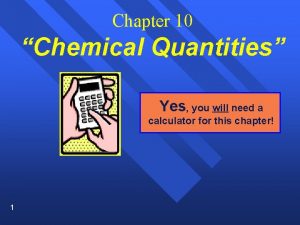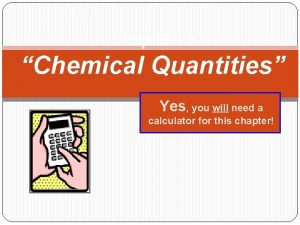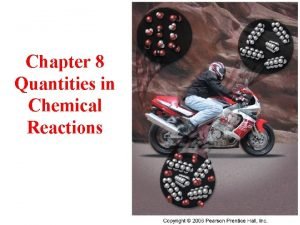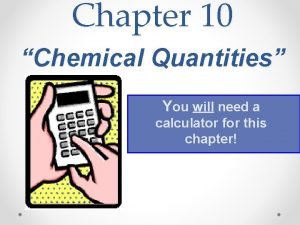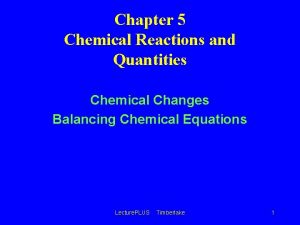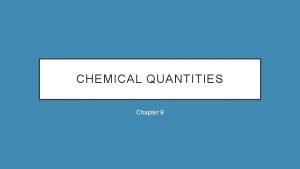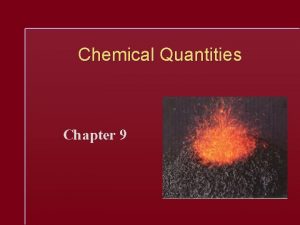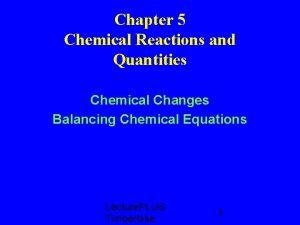Chapter 10 Chemical Quantities Yes you will need







































































- Slides: 71

Chapter 10 “Chemical Quantities” Yes, you will need a calculator for this chapter! NOT TODAY, but every other day of Chapter 10!!! TODAY YOU NEED: -PERIODIC TABLE 1 -PAPER FOR NOTES

Bellringer: n. BR #8: How many doughnuts are in 2. 5 dozen? 2

Agenda Bellringer #8 n 10. 1 objectives n Lecture n Exit slip 10. 1 n Homework: – Tonight Section 10. 1 Practice Problems #1 -8; Section Assessment #13 -15 n 3

Section 10. 1 The Mole: A Measurement of Matter n OBJECTIVES: –Describe methods of measuring the amount of something. 4

Section 10. 1 The Mole: A Measurement of Matter n OBJECTIVES: –Define Avogadro’s number. 5

Section 10. 1 The Mole: A Measurement of Matter n OBJECTIVES: –Distinguish between the atomic mass of an element and its molar mass. 6

Section 10. 1 The Mole: A Measurement of Matter n OBJECTIVES: –Describe how the mass of a mole of a compound is calculated. 7

How do we measure items? You can measure mass § In grams § or volume § In liters § or you can count pieces. § In moles § 8

What is the mole? NOT this kind of mole! 9

Moles (is abbreviated: mol) 23 § 1 mole = 6. 02 x 10 of the representative particles. § It is based on the number of carbon atoms in exactly 12 grams of carbon-12. § Like a much larger dozen § 6. 02 x 1023 is called: 10 Avogadro’s number.

6. 02 x 1023 n 602, 000, 000, 000 n You DON’T want to write this EVERYTIME!!!!! 11

Similar Words for an amount Pair: 1 pair of shoelaces = 2 shoelaces § Dozen: 1 dozen oranges = 12 oranges § Gross: 1 gross of pencils = 144 pencils § Ream: 1 ream of paper 12 = 500 sheets of paper §

What are Representative Particles? § 13 The smallest pieces of a substance: 1) Molecular compound or Ionic Compound: it is the molecule or it is the formula unit (made of ions). 2) Element: it is the atom. » Remember the 7 diatomic elements? (made of molecules)

Counting Representative Particles n How many oxygen atoms in the following? 3 atoms of oxygen Ca. CO 3 12 (3 x 4) atoms of oxygen Al 2(SO 4)3 n How many atoms in the following? 3 total atoms Ca. Cl 2 3 total atoms Na. OH Al 2(SO 4)3 17 total atoms 14

Measuring Moles in Terms of Molecules n Counting Representative Particles is useful in MOLE CONVERSION because: – 1 mole = 6. 02 x 1023 molecules – 1 mole = 6. 02 x 1023 atoms 15

Practice problems (coverting moles to molecules) § How many molecules of CO 2 are in 4. 56 moles of CO 2? 2. 75 x 10 molecules How many moles of water is 5. 87 x 1022 molecules? 0. 0975 mol (or 9. 75 x 10 ) How many moles is 7. 78 x 1024 formula units of Mg. Cl 2? 12. 9 moles 24 § -2 § 16

Measuring Moles in Terms of Mass § § 17 Remember relative atomic mass? - The relative atomic mass is found on the periodic table. The decimal number on the periodic table is also the mass of 1 mole of those atoms in grams. For example 1 mole of Cl = 35. 453 g of Cl (35. 453 g is found on the periodic table) Knowing that 1 mole equals the mass of the periodic table is helpful in calculating problems

Measuring Mole in Terms of Mass 1 mole = molar mass of ANY element (found on periodic table) n Molar Mass = 1 mole n 18

Examples (converting mole to mass or mass to mole) § How much would 2. 34 moles of carbon weigh? 28. 1 grams C § How many moles of magnesium is 24. 31 g of Mg? 1 mol Mg 19

What about compounds? § § 20 in 1 mole of H 2 O molecules there are two moles of H atoms and 1 mole of O atoms (think of a compound as a molar ratio) To find the mass of one mole of a compound –determine the number of moles of the elements present –Multiply the number times their mass (from the periodic table) –add them up for the total mass

Calculating Formula Mass Calculate the formula mass of magnesium carbonate, Mg. CO 3. 24. 3 g 21 + 12 g + 3 x (16. 00 g) = 84. 3 g Thus, 84. 3 grams is the formula mass for Mg. CO 3.

Review of 10. 1 Measurement is by – Count (moles) – Mass (grams) – Volume (liters) n Avogadro’s number – 6. 022 x 1023 of anything n Atomic mass Mass of one atom (very small) n Molar mass Mass of one mole of an atom, molecule, or formula unit n 22 What you see on periodic table is either one) n

Review of 10. 1 n Calculating molar mass of a formula – Add molar mass of each atom in a formula – Example: H 2 O has: » 2 hydrogen atoms (1. 0079 x 2) = 2. 0158 amu » 1 oxygen atom (15. 999) = 15. 999 amu H 2 O molar mass = 18. 0148 amu (rounded to 4 sig figs = 18. 01 amu) 23

Bellringer #9 (Feb 23 rd, 2011) n 24 How many moles are in 12. 04 x 1023 molecules of H 2 O? n Calculate the average atomic mass of: – Sugar: C 6 H 12 O 6 C 2 H 4 – Methane:

Agenda and Objective n n n 25 Objective: Practice Calculating Mole Conversion Problems and Calculating Molar Mass Bellringer #9 HW Check Homework Problems on Board Begin Mole Conversion Wkst #1 Hmwk: – 10. 2 Cornell Notes (due tomorrow) – Mole Conversion Wkst (due Friday)

Bellringer #10 (Feb 24 th, 2011) n 26 Write out how the problem below would be solved (include ALL the steps needed) – How many grams would be in 3. 5 moles of Na. OH?

Agenda (Feb 23 rd, 2011) Bellringer #10 n Check 10. 2 Cornell Notes n Write 10. 2 Objectives n Section 10. 2 Lecture n Exit Slip 10. 2 n Homework: Section 10. 2 Practice Problems #16, 18 -21 and 10. 2 Section Assessment #24 -30 n 27

Section 10. 2 Mole-Mass and Mole-Volume Relationships n OBJECTIVES: 28 –Describe how to convert the mass of a substance to the number of moles of a substance, and moles to mass.

Section 10. 2 Mole-Mass and Mole-Volume Relationships n OBJECTIVES: –Identify the volume of a quantity of gas at STP. 29

Molar Mass § Molar mass is the generic term for the mass of one mole of any substance (expressed in grams/mol) § The same as: 1) Gram Molecular Mass (for molecules) 2) Gram Formula Mass (ionic compounds) 3) Gram Atomic Mass (for elements) 30 – molar mass is just a much broader term than these other specific masses

Examples Calculate the molar mass of the following and tell what type it is: = 78 g/mol gram formula mass Na 2 S = 92 g/mol gram molecular mass N 2 O 4 C = 12 g/mol gram atomic mass Ca(NO 3)2 = 164 g/mol gram formula mass C 6 H 12 O 6 = 180 g/mol gram molecular mass (NH 4)3 PO 4 = 149 g/mol gram formula mass § 31

Since Molar Mass is… § The number of grams in 1 mole of atoms, ions, or molecules, § We can make conversion factors from these. - To change between grams of a compound and moles of a compound. 32

For example § How many moles is 5. 69 g of Na. OH? (Solution on next slides) 33

For example n 34 How many moles is 5. 69 g of Na. OH?

For example 35 n How many moles is 5. 69 g of Na. OH? l We need to change 5. 69 grams Na. OH to moles

For example n How many moles is 5. 69 g of Na. OH? We need to change 5. 69 grams Na. OH to moles l 1 mole Na = 23 g 1 mol O = 16 g 1 mole of H = 1 g l 36

For example n How many moles is 5. 69 g of Na. OH? We need to change 5. 69 grams Na. OH to moles l 1 mole Na = 23 g 1 mol O = 16 g 1 mole of H = 1 g l 1 mole Na. OH = 40 g l 37

For example n How many moles is 5. 69 g of Na. OH? We need to change 5. 69 grams Na. OH to moles l 1 mole Na = 23 g 1 mol O = 16 g 1 mole of H = 1 g l 1 mole Na. OH = 40 g l 38

For example n How many moles is 5. 69 g of Na. OH? We need to change 5. 69 grams Na. OH to moles l 1 mole Na = 23 g 1 mol O = 16 g 1 mole of H = 1 g l 1 mole Na. OH = 40 g l 39

The Mole-Volume Relationship § Many of the chemicals we deal with are in the physical state as: gases. - They are difficult to weigh (or mass). § But, we may still need to know how many moles of gas we have. § Two things effect the volume of a gas: a) Temperature and b) Pressure § We need to compare all gases at the 40 same temperature and pressure.

Standard Temperature and Pressure 0ºC and 1 atm pressure - is abbreviated “STP” § At STP, 1 mole of any gas occupies a volume of 22. 4 L - Called the molar volume § This is our fourth equality: § 41 1 mole of any gas at STP = 22. 4 L

Practice Examples § What is the volume of 4. 59 mole of CO 2 gas at STP? = 103 L § How many moles is 5. 67 L of O 2 at STP? = 0. 253 mol § What is the volume of 8. 8 g of CH 4 gas at STP? = 12. 3 L 42

Exit Slip 10. 2 (on half sheet of paper) n Write ALL the things we have learned that equal 1 mole. 43

Bellringer #11 (Feb 25 th, 2011) n 44 Write the SET UP for the problem below: – How many molecules are in 44. 8 L of CH 4 gas at STP?

Agenda (Feb 25 th, 2011) n n n n 45 Objective: Review ALL mole conversions Bellringer #11 HW Check Review of mole values Density-Molar Mass Conversions Questions about HW Begin Conversion Wkst HW: Complete Conversion Wkst #2 – Quiz MONDAY!!!!

Summary of Mole Values n 46 These four items are all equal: a) 1 mole b) molar mass (in grams/mol) c) 6. 02 x 1023 representative particles (atoms, molecules, or formula units) d) 22. 4 L of gas at STP Thus, we can make conversion factors from these 4 values!

Density of a gas D = m / V (density = mass/volume) - for a gas the units will be: g / L § We can determine the density of any gas at STP if we know its formula. § To find the density we need: 1) mass and 2) volume. § If you assume you have 1 mole, then the mass is the molar mass (from periodic table) 47§ And, at STP the volume is 22. 4 L. §

Practice Examples (D=m/V) § Find the density of CO 2 at STP. D = 44 g/22. 4 L = 1. 96 g/L § Find the density of CH 4 at STP. D = 16 g/22. 4 L = 0. 714 g/L 48

Another way: § § 49 § If given the density, we can find the molar mass of the gas. Again, pretend you have 1 mole at STP, so V = 22. 4 L. m=Dx. V modify: D = m/V to show: “m” will be the mass of 1 mole, since you have 22. 4 L of the stuff. What is the molar mass of a gas with a density of 1. 964 g/L? = 44. 0 g/mol How about a density of 2. 86 g/L? = 64. 0 g/mol

Bellringer #12 (Mar 1 st, 2011) n 50 Ms. Ingham buys four 12 piece pizzas for her class. One student eats 4 pieces of one pizza. What PERCENT of 1 pizza did this student eat?

Agenda (Mar 1 st, 2011) Bellringer #11 n Cornell Notes Check n Write 10. 3 Objectives n 10. 3 Lecture n Exit Slip 10. 3 n Hmwk: 10. 3 Practice Problems #3337, 39; 10. 3 Section Assessment #4044 n 51

Section 10. 3 Percent Composition and Chemical Formulas n OBJECTIVES: –Describe how to calculate the percent by mass of an element in a compound. 52

Section 10. 3 Percent Composition and Chemical Formulas n OBJECTIVES: –Interpret an empirical formula. 53

Section 10. 3 Percent Composition and Chemical Formulas n OBJECTIVES: –Distinguish between empirical and molecular formulas. 54

Calculating Percent Composition of a Compound § 1) 2) 55 Like all percent problems: part x 100 % = percent whole Find the mass of each of the components (the elements), Next, divide by the total mass of the compound; then x 100

Example § Calculate the percent composition of a compound that is made of 29. 0 grams of Ag with 4. 30 grams of S. 56 29. 0 g Ag X 100 = 87. 1 % Ag 33. 3 g total 4. 30 g S X 100 = 12. 9 % S 33. 3 g total Total = 100 %

Getting it from the formula If we know the formula, assume you have 1 mole, § then you know the mass of the elements and the whole compound (these values come from the periodic table!). § 57

Examples § Calculate the percent composition of C 2 H 4? 85. 7% C, 14. 3 % H § How about Aluminum Carbonate? 23. 1% Al, 15. 4% C, and 61. 5 % O 58

Formulas Empirical formula: the lowest whole number ratio of atoms in a compound. Molecular formula: the true number of atoms of each element in the formula of a compound. • Example: molecular formula for benzene is C 6 H 6 (note that everything is divisible by 6) • Therefore, the empirical formula = (the lowest whole number ratio) 59 CH

Formulas (continued) Formulas for ionic compounds are ALWAYS empirical (the lowest whole number ratio = cannot be reduced). Examples: Na. Cl 60 Mg. Cl 2 Al 2(SO 4)3 K 2 CO 3

Formulas (continued) Formulas for molecular compounds MIGHT be empirical (lowest whole number ratio). Molecular: (Correct formula) Empirical: (Lowest whole number ratio) 61 H 2 O C 6 H 12 O 6 C 12 H 22 O 11 H 2 O CH 2 O C 12 H 22 O 11

Calculating Empirical Just find the lowest whole number ratio C 6 H 12 O 6 = CH 2 O CH 4 N = this is already the lowest ratio. § A formula is not just the ratio of atoms, it is also the ratio of moles. § In 1 mole of CO 2 there is 1 mole of carbon and 2 moles of oxygen. § In one molecule of CO 2 there is 1 atom 62 of C and 2 atoms of O. §

Calculating Empirical § 1) We can get a ratio from the percent composition. Assume you have a 100 g sample - the percentage become grams (75. 1% = 75. 1 grams) 2) 3) 63 Convert grams to moles. Find lowest whole number ratio by dividing each number of moles by the smallest value.

Example § Calculate the empirical formula of a compound composed of 38. 67 % C, 16. 22 % H, and 45. 11 %N. § Assume 100 g sample, so 38. 67 g C x 1 mol C = 3. 22 mole C 12. 0 g C 16. 22 g H x 1 mol H = 16. 22 mole H 1. 0 g H 45. 11 g N x 1 mol N = 3. 22 mole N 14. 0 g N § § § 64 Now divide each value by the smallest value

Example § § The ratio is 3. 22 mol C = 1 mol C 3. 22 mol N 1 mol N The ratio is 16. 22 mol H = 5 mol H 3. 22 mol N 1 mol N = C 1 H 5 N 1 § § 65 which is = CH 5 N A compound is 43. 64 % P and 56. 36 % O. What is the empirical formula? = P 2 O 5 Caffeine is 49. 48% C, 5. 15% H, 28. 87% N and 16. 49% O. What is its empirical formula? = C 4 H 5 N 2 O

Bellringer #13 (Mar 2 nd, 2011) Figure out the empirical formula for the following: – C 2 H 6 – C 12 H 22 O 6 n Caffeine is 49. 48% C, 5. 15% H, 28. 87% N and 16. 49% O. What is its empirical formula? n 66

Bellringer #13 (Mar rd th th 3 , 5 , 8 nd 2 , 2011) Figure out the empirical formula for the following: – C 2 H 6 – C 12 H 22 O 6 n A compound contains 18. 8% sodium, 29. 0% chlorine, and 52. 2% oxygen, by mass. Determine the empirical formula. n 67

Agenda (Mar 2 nd, 2011) n n n 68 Bellringer #13 HW Check Review Calculating Empirical Formula Calculating Molecular Formula Begin Unit 10 Review Wkst Hw: Complete Unit 10 Review (by Friday) – TEST FRIDAY!!!! (Bring calculators)

Empirical to molecular Since the empirical formula is the lowest ratio, the actual molecule would weigh more. §By a whole number multiple. § Divide the actual molar mass by the empirical formula mass – you get a whole number to increase each coefficient in the empirical formula § Caffeine has a molar mass of 194 g. 69 what is its molecular formula? = C 8 H 10 N 4 O 2 §

Practice Problems: Determining Molecular Formula 70 n A compound contains 18. 8% sodium, 29. 0% chlorine, and 52. 2% oxygen, by mass. Determine the empirical formula. What is the molecular formula if the molar mass is 122. 44 g/mol? n A compound with an empirical formula of C 2 H 8 N and a molar mass of 46 grams per mole. What is the molecular formula of this compound? n A well-known reagent in analytical chemistry, dimethylglyoxime, has the empirical formula C 2 H 4 NO. If its molar mass is 116. 1 g/mol, what is the molecular formula of the compound?

71
 I said yes i will analysis
I said yes i will analysis Yes yes lord amen
Yes yes lord amen Cloud cap technologies
Cloud cap technologies Angular acceleration vs linear acceleration
Angular acceleration vs linear acceleration Yes yes lord amen
Yes yes lord amen Chapter 7 chemical quantities answer key
Chapter 7 chemical quantities answer key Chemistry chapter 10 chemical quantities
Chemistry chapter 10 chemical quantities Chapter 7 chemical quantities answer key
Chapter 7 chemical quantities answer key Chemical quantities chapter 10
Chemical quantities chapter 10 Chapter 10 chemical quantities practice problems answer key
Chapter 10 chemical quantities practice problems answer key Chapter 9 chemical quantities
Chapter 9 chemical quantities You yes you stand still laddie
You yes you stand still laddie The calculation of quantities in chemical equations
The calculation of quantities in chemical equations The calculation of quantities in chemical equations
The calculation of quantities in chemical equations Chemical quantities calculator
Chemical quantities calculator Unit chemical quantities the mole 1 step
Unit chemical quantities the mole 1 step I wish you the strength
I wish you the strength Split speech punctuation
Split speech punctuation Chapter 7 review chemical formulas and chemical compounds
Chapter 7 review chemical formulas and chemical compounds Modern chemistry chapter 7 review answers
Modern chemistry chapter 7 review answers Are kc and kp equal
Are kc and kp equal Yesno question
Yesno question Do you like bananas?
Do you like bananas? Do you like bananas yes i do
Do you like bananas yes i do Do you speak english yes i can
Do you speak english yes i can Do you like bananas yes i do
Do you like bananas yes i do I am you are he is
I am you are he is Do you like banana
Do you like banana Do you like yes i do
Do you like yes i do Unit of quantity
Unit of quantity Section 2 reinforcement classifying chemical reactions
Section 2 reinforcement classifying chemical reactions Section 2 classifying chemical reactions
Section 2 classifying chemical reactions Chemical reactions section 1 chemical changes
Chemical reactions section 1 chemical changes Chapter 10 chemical reactions answer key
Chapter 10 chemical reactions answer key Chapter 9 chemical reactions answers
Chapter 9 chemical reactions answers Tribromine octoxide formula
Tribromine octoxide formula You need a passport to cross the
You need a passport to cross the English paragraph
English paragraph You only need to be lucky once
You only need to be lucky once Encoder and decoder applications
Encoder and decoder applications Example of why oxford comma is important
Example of why oxford comma is important Love is not all: it is not meat nor drink
Love is not all: it is not meat nor drink Seed paragraph
Seed paragraph Fsa writing outline
Fsa writing outline Do you have to sign your passport
Do you have to sign your passport Is argumentative a genre
Is argumentative a genre Everything you need to know about the odyssey
Everything you need to know about the odyssey When climbing where do you need high friction
When climbing where do you need high friction Cross traffic is eliminated on controlled access expressway
Cross traffic is eliminated on controlled access expressway I. choose the correct answer.
I. choose the correct answer. Let's be a good friends
Let's be a good friends You need to make at least 150 sandwiches for a picnic
You need to make at least 150 sandwiches for a picnic Much do you need health
Much do you need health You have need of endurance
You have need of endurance Lord i come i confess
Lord i come i confess All i need is the air that i breathe and to love you abba
All i need is the air that i breathe and to love you abba Let's go question tag
Let's go question tag Money is all you need
Money is all you need Lindell cooley i need you more
Lindell cooley i need you more You say you love the rain
You say you love the rain Eat meals that are nutritious agree or disagree
Eat meals that are nutritious agree or disagree If you think you can you can poem
If you think you can you can poem Tell me what you eat and i shall tell you what you are
Tell me what you eat and i shall tell you what you are I will follow wherever you may go
I will follow wherever you may go Chapter 1: the need for cybersecurity
Chapter 1: the need for cybersecurity Need a service chapter 5
Need a service chapter 5 Identify and meet a market need
Identify and meet a market need Need a service chapter 15
Need a service chapter 15 Need a service chapter 14
Need a service chapter 14 Need a service chapter 10
Need a service chapter 10 Need a service chapter 12
Need a service chapter 12 Service escape
Service escape
